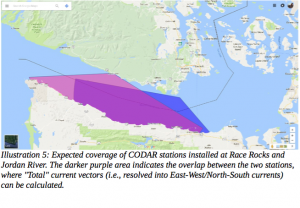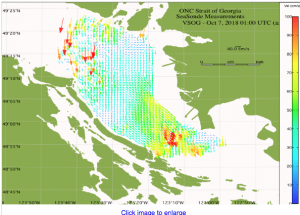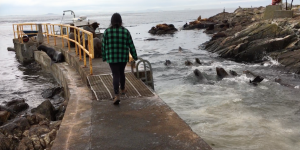Pam Birley of Leistershire England has regularly photographed this harbour seal which she named 6-spot , since 2008.. Their lifespan is 25-30 years.
- 6-spot – first photographed at Race Rocks in 2008

Pam Birley of Leistershire England has regularly photographed this harbour seal which she named 6-spot , since 2008.. Their lifespan is 25-30 years.
Juan de Fuca _CODAR_backgrounder
 Today Guy drove me out to Race Rocks with Kevin Bartlett, Marine Equipment, Specialist with Ocean Networks Canada. They had installed equipment earlier in the year but had ro change the frequency of broadcasting before it is operational. Kevin was making repairs, one being fixing the conduit at the base of the tower which had been disturbed by sealions. When this equipment is fully operational it will give acurate current vectors for the eastern entrance of the Strait of Juan de Fuca.
Today Guy drove me out to Race Rocks with Kevin Bartlett, Marine Equipment, Specialist with Ocean Networks Canada. They had installed equipment earlier in the year but had ro change the frequency of broadcasting before it is operational. Kevin was making repairs, one being fixing the conduit at the base of the tower which had been disturbed by sealions. When this equipment is fully operational it will give acurate current vectors for the eastern entrance of the Strait of Juan de Fuca.
 Sample from a similar station now in operation:
Sample from a similar station now in operation:
It was has been noticeable this year that instead of hauling out on the neighbouring islets of the Race Rocks Archipelago, the sealions are hauled out entirely on the main island of Great Race Rock. They have heavily impacted the vegetated areas .
Pam Birley sent these photos today that she took on the remote camera5:
Weather
Boats/Visitors
Maintenance
Ecological
Census
Today, Guy Ouradou from Pearson College drove me out to Race Rocks Ecological reserve with David Obura, Pearson College alumni from Kenya year 10. The main change since I was there last was the predominance of California sea lions over most of the island. Northern sealions occupied a small portion of rock near the docks and the isthmus below the light tower. Each year the college has to put up an electric fence to prevent the sealions from invading the centre of the island which can result in damage to conduits, and facilities.
A new fence system is being installed this year, which has so far proven to be very effective. Another aspect of the sealions being on the centre part of the island is that they have been damaging the structure of the rocks arranged in the areas of the aboriginal burial cairns. The big change in sealion distribution is that previously they have concentrated on West Race Rocks, North Race Rocks and the south Islands off the tower. This year there are none out on those islands and they are all on the main island.
I also was able to observe the equipment installed by Oceans Network Canada for CODAR. Hopefully we can get a connection to the output of the data obtained from this equipment when we neet with Kevin Bartlett from Ocean Networks Canada next week on Sept 28.
Earlier this year, Lester Pearson College upgraded the solar batteries which have served for the past 11 years. New inverters were also installed.
 Leaving the island we have to deal with a dock full of sealions which have returned since our arrival.
Leaving the island we have to deal with a dock full of sealions which have returned since our arrival.
Weather
Boats/Visitors
Maintenance
Ecological
Weather
Boats/Visitors
Maintenance
Ecological
Weather
Boats/Visitors
Maintenance
Ecological
Census
Weather
Boats/Visitors
Maintenance
Ecological
Weather
Boats/Visitors
Maintenance
Ecological